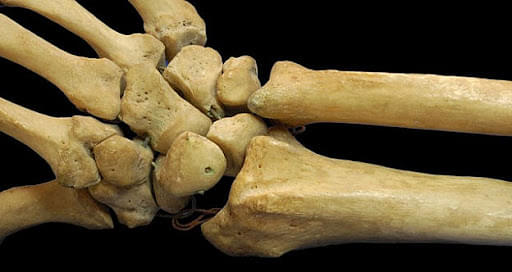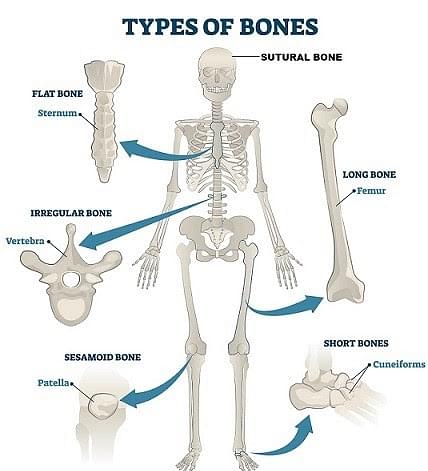
Collegedunia Team Content Curator
Content Curator
Bone is a rigid tissue that is a component of all animals' vertebrate skeletons. Bones are responsible for protecting the body's various organs, as well as producing red and white blood cells. Bones also provide shape and support to the body, as well as aiding in movement.
| Table of Content |
Read More: Joints
Bones also contribute to mineral storage in the body. Bones serve several purposes and are both lightweight and strong. Bones have a complex external and internal structure and can be found in a wide range of shapes and sizes.

What is Bone?
The osseous tissue, also known as bone tissue, is a specialized connective tissue that is also very hard. The honeycomb matrix, which is responsible for the rigidity or toughness of the bone, resembles the bone tissue on the inside. There are many distinct types of bone cells in bone tissue, and it is not made up of just one type of cell. Bone cells such as osteoblasts and osteoclasts are involved in bone formation and mineralization, whereas osteoclasts are responsible for bone tissue resorption or reabsorption. Flattened osteoblasts transform into lining cells that aid in the formation of a protective layer on the bone surface. Both organic and inorganic components of bone minerals, which are made up of diverse salts, make up the mineralized matrix of bone tissue.
Bone tissue is a mineralized tissue that consists of two types of bones: cancellous bone and cortical bone. Other types of tissue found in the bone include bone marrow, blood vessels, cartilage, periosteum, and endosteum.

Types of Bones
Types of Bone Cells
Bone is thought to be a metabolically active tissue made up of various cell types. When viewed microscopically, bones are composed of hard, homogeneous intercellular material within or upon which we consider four distinct cell types: osteoblasts, osteocytes, osteoclasts, and bone mesenchymal stem cells.
Osteoblasts are primarily responsible for mineralization and bone tissue formation. They also deposit and synthesize the protein matrix of new intercellular materials on bone surfaces.
Osteoclasts are multinucleated cells that work from the bone's surface. And aids in bone reabsorption through a direct chemical and enzymatic attack

Types of Bone Cells
Osteocytes are trapped within the intercellular material and live in a cavity known as a lacuna, where they communicate with other osteocytes and free bone surfaces via extensive filamentous protoplasmic extensions. Both osteocytes and osteoclasts are involved in bone tissue reabsorption.
Osteoprogenitors are the cells that give rise to both osteocytes and osteoclasts. Undifferentiated mesenchymal stem cells of the bones are found in the loose connective tissue between the condensed fibrous tissue that covers the outside of the bone and the trabeculae that run along the vascular channel.
Mesenchymal stem cells are multipotent stem cells found in bone marrow that play an important role in the formation and repair of skeletal tissues such as cartilages, fat sound in bone marrow, and bones.
Types of Bones
The skeletal system of the body is made up of bones, which are primarily responsible for the storage of various macronutrients, providing rigidity, and hosing the bone marrow. Bones are also responsible for the production of red and white blood cells, as well as providing structural outline and movement.

Bone Types
Long Bones: Long bones are distinguished by a shaft, the diaphysis, that is much longer than it is wide. A shaft and a diaphysis connect two epiphyseal ends. The epiphysis is composed primarily of compact bones with a small amount of marrow and is found within the medullary cavity and areas of spongy, cancellous bones at the ends of the bones. The long bones consist of the humerus, ulna, radius, fibula, tibia, femur, metacarpal bones, and phalanges.
Short Bones: The short bones consist of a thin layer of compact bones surrounding a spongy interior that is more or less cuboid in shape. The bones of the wrist and ankles are considered small bones in the human body.
Flat Bones: Flat bones are curved and thin in general. Both the spongy bones and the bone marrow space are covered by two parallel layers of compact bones. Skull bones, ribs, sternum, and scapulae are all members of the flat bones group.

Flat Bones
Irregular bones: are made up of thin layers of compact bones that cover a mass of mostly spongy bones. Their bones are complicated and irregularly shaped. The irregular bones are classified based on their bone content rather than their shape. The bones of the spine, pelvis, and a few bones of the skull fall into the category of irregular bones.
Sesamoid Bones: Sesamoid bones are embedded in the tendons. They are located at the ends of the long bones, where the tendons cross. Sesamoid bones reduce friction, which protects the tendons from excessive wear and stress. The sesamoid bones include the patella and the pisiform.
Read Also: Leg Muscles
Composition of Bones
The main components of bone are collagen fibres and inorganic bone minerals in the form of small crystals. The human body's living bone is composed of 20% water and its dry mass is composed of approximately 60-70 percent bone numerals. The bone also contains trace amounts of other substances such as inorganic salts and proteins, but it is primarily composed of collagen.

Composition of Bones
List of Bones in Human Body
The Spine
A fully grown-up adult's spine has 26 bones, whereas a child's spine has 36 bones. The 26 spine bones are listed below.
- The cervical vertebrae are made up of seven bones.There are 12 ones in the Thoracic vertebrae.
- The lumbar vertebrae are made up of five bones.
- There is one Sacrum bone. When a child is born, he or she has five bones; however, as the child grows, the bones fuse to form a single bone.

Spine
Chest
In humans, there are 25 bones in the chest, but there are sometimes additional cervical ribs.
- The ribs in a pair of twelve have twenty four bones.
- One or three sternum bones.
Skull
The skull is made up of 23 bones. When the middle ear is included, the head will have 29 bones in total. The names and numbers of the bones are listed below.
- There are eight cranial bones.
- A single occipital bone
- Two parietal bones
- Two temporal bones
- only one frontal bone
- A single sphenoid bone
- A single ethmoid bone
- There are 15 facial bones in total.
- Two bones in the nose
- Two Maxillae (upper jaw bones)
- Two lacrimal bones
- Two palatine ribs
- Two cheekbones
- Two lower nasal conchas
- One vomer
- One bone of the hyoid
- Only one mandible
- The middle ear has six bones, three on each side.
- Two malleus
- Two incus and
- Two stapes

Skull
Arm and the Hand
The arms have a total of 64 bones. The upper arm bone is made up of six bones in total, three on each side. Two humeri, one pelvic girdle, two scapula bones, and two clavicles. The lower arm is made up of four bones, two on each side: the Ulna and the Radius. The hand has 54 bones, 27 on each side, and the names of the bones are listed below.
- One carpel
- Two Scaphoid bones
- Two lunate bone
- Two Triquetral bone
- Two Pisiform bone
- Two Capitate bone
- Two Trapezium
- Two Trapezoid bone
- Two Hamate bone
- Ten Metacarpals bones in total with five on each side.
- Phalanges of the hand
- Ten Proximal phalanges in total with five on each side.
- Eight Intermediate phalanges in total with four on each side
- Ten Distal phalanges in total with five on each side.
Pelvic
The pelvis, also known as the hip bone, is made up of three regions that are joined together to form two coxal bones. Ilium, ischium, and pubis are the names of the two bones. The sacrum and coccyx connect the two hip bones to form the pelvis.

Pelvic Gridle
Legs and Feet
The legs are made up of 60 bones. We have two Femur bones, two Patella or knee caps bones, two Tibia bones, and two Fibula bones. We have fifty two bones in total in the foot, with twenty six bones per foot. The tarsus or tarsals are made up of
- Two Calcaneus or heel bone
- Two bones in the Talus
- Two Navicular bones
- Two Medial cuneiform bones
- Two Intermediate cuneiform bones
- Two Lateral cuneiform bones
- Two Cuboid bones
Things to Remember
- Bones and cartilages make up our skeletal system.
- There are two sections to the skeletal system: axial and appendicular.
- The head, spinal column, ribs, and sternum make up the axial skeleton.
- Limb bones and girdles form the appendicular skeleton.
- Between bones or between bone and cartilage, fibrous, cartilaginous, and synovial joints occur.
- Synovial joints are vital in locomotion because they allow for a lot of mobility.
Read Also: Pelvic Bones
Sample Questions
Ques: What is a bone, and what are the different types of bone tissues?
Ans: Bone is the living tissue that makes up the skeleton of the body. There are three kinds of bone tissue.
Compact Tissue: The harder and outer tissue of the bones.
Cancellous Tissue: The cancellous tissues are the spongy-like tissues found inside the bones.
Subchondral Tissue: Subchondral tissue is the smooth tissue at the ends of bones that is covered by another type of tissue known as cartilage tissue. Adults have cartilage, which is a specialised connective tissue.
Ques: Which is the largest bone present in the skeleton of a human?
Ans: The largest bone in the human body is the femur, also known as the thigh bone. The femur is the human body's longest, largest, and strongest bone. The femur, which runs from the knee to the hip, bears the entire weight of the upper body.
Ques: What are the various types of movements that human body cells exhibit?
Ans: 1. Amoeboid movement: Cellular skeletal filaments and microfilaments are responsible for the formation of pseudopodia. The pseudopodia is a cytoplasmic extension that extends in the direction that the cell needs to move. It aids in the movement of the cell in this way. As a result, they can move towards foreign particles and diseased cells and capture them.
- Ciliary effect: Reproductive cells, such as sperms and ovaries, exhibit ciliary movement. This movement aids the passage of ova through the fallopian tubes and into the uterus.
- Muscular movement: Muscle cells move through a type of contraction known as muscular contraction like heart beat, tongue rolling etc.
Ques: Describe the structure of the bones.
Ans: There are two types of bones in a bone: cortical or compact bones and cancellous, trabecular, or spongy bones.
The cortical bone contributes to the formation of a dense cylinder down the bone's shaft that surrounds the central marrow cavity. The cortical bone has a lower surface area than the cancellous bones due to its low porosity, but it accounts for eighty percent of the mass of the bones in the human body. The cancellous or trabecular bones are located at the end of the long bone and account for 20% of the total mass of the skeleton. The cancellous bones have an open honeycomb structure as well.
Ques: In a human body, how many bones are there?
Ans: A newborn baby has 270 bones in his or her body at birth, but as time passes, many of these bones fuse together, and an adult body has 206 separate bones (excluding the numerous sesamoid bones). The middle ear's stapes is the smallest bone in the body, whereas the femur, or thigh bone, is the largest.





Comments